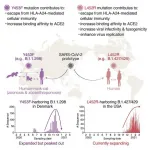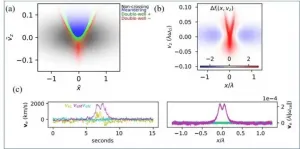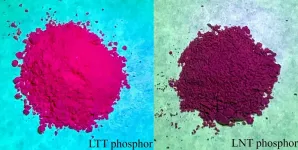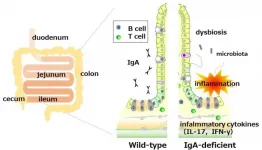INFORMATION:
This research was supported by the WHOI Postdoctoral Scholar Program, the U.S. National Science Foundation, the Australian Research Council, the Andrew W. Mellon Foundation Award for Innovative Research, and the James E. and Barbara V. Moltz Fellowship for Climate- Related Research.
About Woods Hole Oceanographic Institution
The Woods Hole Oceanographic Institution (WHOI) is a private, non-profit organization on Cape Cod, Massachusetts, dedicated to marine research, engineering, and higher education. Established in 1930, its primary mission is to understand the ocean and its interaction with the Earth as a whole, and to communicate an understanding of the ocean's role in the changing global environment. WHOI's pioneering discoveries stem from an ideal combination of science and engineering--one that has made it one of the most trusted and technically advanced leaders in basic and applied ocean research and exploration anywhere. WHOI is known for its multidisciplinary approach, superior ship operations, and unparalleled deep-sea robotics capabilities. We play a leading role in ocean observation and operate the most extensive suite of data-gathering platforms in the world. Top scientists, engineers, and students collaborate on more than 800 concurrent projects worldwide--both above and below the waves--pushing the boundaries of knowledge and possibility. For more information, please visit http://www.whoi.edu
Authors: Caroline C. Ummenhofer1,2 *, Sujata A. Murty1,3, Janet Sprintall4, Tong Lee5, and Nerilie J. Abram6,7
Affiliations:
1Department of Physical Oceanography, Woods Hole Oceanographic Institution, Woods Hole, MA, USA
2ARC Centre of Excellence for Climate Extremes, University of New South Wales, Sydney, NSW, Australia
3Department of Atmospheric and Environmental Sciences, University at Albany, State University of New York, Albany, NY, USA
4Scripps Institution of Oceanography, University of California, San Diego, La Jolla, CA, USA
5Jet Propulsion Laboratory, California Institute of Technology, Pasadena, CA, USA
6Research School of Earth Sciences, The Australian National University, Canberra, ACT, Australia
7ARC Centre of Excellence for Climate Extremes, The Australian National University, Canberra, ACT, Australia
*Corresponding author
Review evaluates the evidence for an intensifying Indian Ocean water cycle
Report calls for better integration of observations, models, and paleo proxies
2021-07-20
(Press-News.org) The Indian Ocean has been warming much more than other ocean basins over the last 50-60 years. While temperature changes basin-wide can be unequivocally attributed to human-induced climate change, it is difficult to assess whether contemporary heat and freshwater changes in the Indian Ocean since 1980 represent an anthropogenically-forced transformation of the hydrological cycle. What complicates the assessment is factoring in natural variations, regional-scale trends, a short observational record, climate model uncertainties, and the ocean basin's complex circulation.
A new review paper takes a broad look at whether heat and freshwater changes in the Indian Ocean are consistent with the increase in rainfall that is expected in response to anthropogenic global warming or whether these changes are due to natural variability on multi-decadal and other timescales along with other factors. That distinction has "big implications for climate risk assessment and for the densely populated regions around the Indian Ocean that are vulnerable to the effects of climate change," says Caroline Ummenhofer, lead author of the paper, Heat and freshwater changes in the Indian Ocean region, published in Nature Reviews Earth & Environment.
The paper brings together various scientific expertise, tools, and data sources to address key questions regarding climate change in the Indian Ocean, says Ummenhofer, associate scientist in the Physical Oceanography Department at the Woods Hole Oceanographic Institution (WHOI). "The different scientific communities need to come together and have very open discussions about what we can tell from our data, how we can compare apples and oranges, and how we can bring all of this information together to have a better understanding of the entire Indian Ocean system," she says.
"Rather than rely on climate models that struggle to accurately represent the complex circulation, we look at many different observational records including measurements of sea level, and the ocean surface and subsurface temperature and salinity," says co-author Janet Sprintall, a research oceanographer at the Scripps Institution of Oceanography, University of California San Diego.
While some changes in the Indian Ocean appear to be a consistent response to anthropogenic global warming, "in general our ocean observational records are still far too short to distinguish the naturally driven variability from the man-made changes," says Sprintall. "This tells us that we need to continue measuring our oceans--particularly below the surface--so that we can better understand these long-term changes and their causes, and so that we can improve our prediction and response to them."
Quantifying the changes in the Indian Ocean heat and freshwater balance warrants a multi-pronged approach across temporal and spatial scales that integrates in situ observations (including Argo floats robotically programmed to measure ocean temperature, salinity, and other properties; moorings; and buoys), remote sensing by satellites to measure rainfall and sea surface salinity, improved numerical modelling simulations, and paleoclimate proxy networks, the authors note.
Corals are an important paleoclimate archive in the ocean because their calcium carbonate skeletons incorporate the chemical properties of past oceans and so reflect past climate and environmental conditions. "Corals are unique environmental archives that allow us to extend our understanding of Indian Ocean variability centuries farther back in time than the observational record," says co-author Sujata Murty, WHOI adjunct scientist and assistant professor in the Department of Atmospheric and Environmental Sciences at the University at Albany, State University of New York. "Including the long-term perspective provided by corals alongside that of observations and remote sensing data enriches our understanding of complex climate and ocean systems and improves our ability to anticipate future changes in a warming world."
Maintaining and expanding current remote sensing, in situ observations, and a network of paleo proxies is "crucial" for "disentangling the effects of multi-decadal natural variability and anthropogenic change on heat and freshwater changes" in the Indian Ocean and the Maritime Continent region between the Indian and Pacific oceans, according to the paper.
The Indian Ocean, the paper notes, "is particularly vulnerable to anthropogenic climate change," in part because the ocean is bounded to the north by the Asian continent. This means that heat from the Pacific Ocean that enters the Indian Ocean through the Indonesian Seas cannot easily exit the basin.
The basin "could be a kind of canary in a coal mine," says Ummenhofer, because those changes now being observed in the Indian Ocean also could happen in other oceans. "We can all benefit from having better observations and a better understanding of the ocean so that we can know whether the changes are a climate change signal or part of a natural cycle."
ELSE PRESS RELEASES FROM THIS DATE:
Spinal fluid biomarkers detect neurodegeneration, Alzheimer's disease in living patients
2021-07-20
PHILADELPHIA--Alzheimer's disease and related diseases can still only be confirmed in deceased patients' brains via autopsy. Even so, the development of biomarkers can give patients and their families answers during life: Alzheimer's disease can be accurately detected via peptides and proteins in a patient's cerebrospinal fluids (CSF), which can be collected through a lumbar puncture and tested while the patient is alive. In 2018, a new framework suggested combining three Alzheimer's disease biomarkers in CSF - pathologic amyloid plaques (A), tangles (T), and neurodegeneration (N), collectively called ATN. According to recent research from the Perelman School ...
SARS-CoV-2 spike mutation L452R evades human immune response and enhances infectivity
2021-07-20
An international team of researchers led by Kumamoto and Tokyo Universities (Japan) have shown that the L452R mutation of the SARS-CoV-2 spike protein, which is common to two mutant strains (Epsilon and Delta), is involved in cellular immunity evasion via the human leukocyte antigen (HLA) A24, and enhances viral infectivity. HLA-A24 is one of the most prominent HLA-class I alleles, especially in East/Southeast Asian populations, which might make them particularly vulnerable to coronavirus variants with this mutation.
The ongoing novel coronavirus (SARS-CoV-2 or COVID-19) pandemic has, as of June 2021, infected over 150 million and killed over 3.5 million people worldwide. Vaccination drives ...
The origin of bifurcated current sheets explained
2021-07-20
A Korean research team has identified the origin of bifurcated current sheets, considered one of the most unsolved mysteries in the Earth's magnetosphere and in magnetized plasma physics.
A POSTECH joint research team led by Professor Gunsu S. Yun of the Department of Physics and Division of Advanced Nuclear Engineering and Dr. Young Dae Yoon from the Pohang Accelerator Laboratory has theoretically established the process of collisionless equilibration of disequilibrated plasma current sheets. In addition, by comparing this with particle simulations and satellite data from NASA, the origin of the bifurcated ...
Synthesis of new red phosphors with a smart material as a host material
2021-07-20
Overview:
Professor Hiromi Nakano of Toyohashi University of Technology used a material with a unique periodical structure (smart material: Li-M-Ti-O [M = Nb or Ta]) as a host material to synthesize new Mn4+-activated phosphors that exhibit red light emissions at 685 nm when excited at 493 nm. Because the valence of the Mn ions in the material changes from Mn4+ to Mn3+ according to the sintering temperature, composition, and crystal structure, there is a difference in the photoluminescence intensity of the phosphors. XRD, TEM, and XANES were used to clarify the relationship between the photoluminescence intensity and the sintering temperature, ...
Tree-ring records reveal Asian monsoon variability
2021-07-20
Chinese researchers along with international colleagues recently reported a 6,700-year-long, precisely dated and well-calibrated tree-ring stable isotope chronology from the Northeastern Tibetan Plateau. It reveals full-frequency precipitation variability in the Asian Summer Monsoon (ASM) from interannual to multimillennial timescales with a long-term decreasing trend and several abrupt climate change events.
The international research team comprised 20 scientists from research groups based in China, Norway, Germany, United Kingdom, USA, Sweden, Canada, and Switzerland ...
No IgA leads to intestinal inflammation in mice
2021-07-20
Tokyo, Japan - While researchers have known for years that immunoglobulin A (IgA) is important for gut health, it has remained unclear exactly what role it plays in preventing infection and disease. But now, researchers from Japan have found that eliminating IgA disrupts the balance of the intestinal ecosystem, making it susceptible to disease.
In a study published online in May in Gut, researchers from Tokyo Medical and Dental University (TMDU) have revealed that IgA deficiency results in substantial inflammation of the ileum, a specific part of the small intestine.
IgA is present in large quantities in the small intestine, where it helps protect the body against microorganisms that could potentially cross the lining of the gut to cause ...
Farm consolidation has negative effect on wild pollinators
2021-07-20
A new study by a team of researchers has found that the consolidation of traditional smallholder farms in China has a devastating effect on the biodiversity of wild pollinators in the area.
Pollinators play an essential role when it comes to supporting global food production.
However, wild pollinators are on the decline for several reasons, including the loss of floral resources and nesting sites. This loss of biodiversity could have far-reaching consequences for global food production in future.
"Biodiversity is essential for all life, with pollinators being one of the most important groups," says Dr Yi Zou from Xi'an Jiaotong-Liverpool ...
Removal of barred owls slows decline of iconic spotted owls in Pacific Northwest, study finds
2021-07-20
CORVALLIS, Ore. - A 17-year study in Oregon, Washington and California found that removal of invasive barred owls arrested the population decline of the northern spotted owl, a native species threatened by invading barred owls and the loss of old-forest habitats.
The conservation and management of northern spotted owls became one of the largest and most visible wildlife conservation issues in United States history after the U.S. Fish and Wildlife Service listed the spotted owl as threatened under the Endangered Species Act in 1990 because of rapid declines in the owl's old-forest habitats. Four years later, the Northwest Forest Plan was adopted and reduced the rate of logging of old-growth forests on federal lands.
Despite more ...
Strong signals
2021-07-20
Tsukuba, Japan - Scientists from the department of Anatomy and Embryology at the Faculty of Medicine of the University of Tsukuba created a computer model to simulate the development of complex structures based on the Delta-Notch signaling pathway. This work may lead to a more comprehensive picture of the process that results in the formation of organs and other physiological systems.
The development of a tiny embryo consisting of undifferentiated cells into a healthy fetus with spatially defined organs depends on the complex interplay between genetic instructions and signaling molecules. For example, "Notch" genes are ...
A machine learning breakthrough: using satellite images to improve human lives
2021-07-20
Berkeley -- More than 700 imaging satellites are orbiting the earth, and every day they beam vast oceans of information -- including data that reflects climate change, health and poverty -- to databases on the ground. There's just one problem: While the geospatial data could help researchers and policymakers address critical challenges, only those with considerable wealth and expertise can access it.
Now, a team based at the University of California, Berkeley, has devised a machine learning system to tap the problem-solving potential of satellite imaging, using low-cost, ...
LAST 30 PRESS RELEASES:
Scalable and healable gradient textiles for multi‑scenario radiative cooling via bicomponent blow spinning
Research shows informed traders never let a good climate crisis go to waste
Intelligent XGBoost framework enhances asphalt pavement skid resistance assessment
Dual-function biomaterials for postoperative osteosarcoma: Tumor suppression and bone regeneration
New framework reveals where transport emissions concentrate in Singapore
NTP-enhanced lattice oxygen activation in Ce-Co catalysts for low-temperature soot combustion
Synergistic interface engineering in Cu-Zn-Ce catalysts for efficient CO2 hydrogenation to methanol
COVID-19 leaves a lasting mark on the human brain
Scientists use ultrasound to soften and treat cancer tumors without damaging healthy tissue
Community swimming program for Black youth boosts skills, sense of belonging, study finds
Specific depressive symptoms in midlife linked to increased dementia risk
An ‘illuminating’ design sheds light on cholesterol
Who is more likely to get long COVID?
Study showcases resilience and rapid growth of “living rocks”
Naval Research Lab diver earns Office of Naval Research 2025 Sailor of the Year
New Mayo-led study establishes practical definition for rapidly progressive dementia
Fossil fuel industry’s “climate false solutions” reinforce its power and aggravate environmental injustice
Researchers reveal bias in a widely used measure of algorithm performance
Alcohol causes cancer. A study from IOCB Prague confirms damage to DNA and shows how cells defend against it
Hidden viruses in wastewater treatment may shape public health risks, study finds
Unlock the power of nature: how biomass can transform climate mitigation
Biochar reshapes hidden soil microbes that capture carbon dioxide in farmland
Reducing saturated fat intake shows mortality benefit, but only in high-risk individuals
Manta rays create mobile ecosystems, study finds
Study: Mixed results in using lipoic acid to treat progressive multiple sclerosis
Norbert Holtkamp appointed director of Fermi National Accelerator Laboratory
New agentic AI platform accelerates advanced optics design
Biologists discover neurons use physical signals — not electricity — to stabilize communication
Researchers discover that a hormone can access the brain by hitchhiking
University of Oklahoma researcher awarded funding to pursue AI-powered material design
[Press-News.org] Review evaluates the evidence for an intensifying Indian Ocean water cycleReport calls for better integration of observations, models, and paleo proxies






